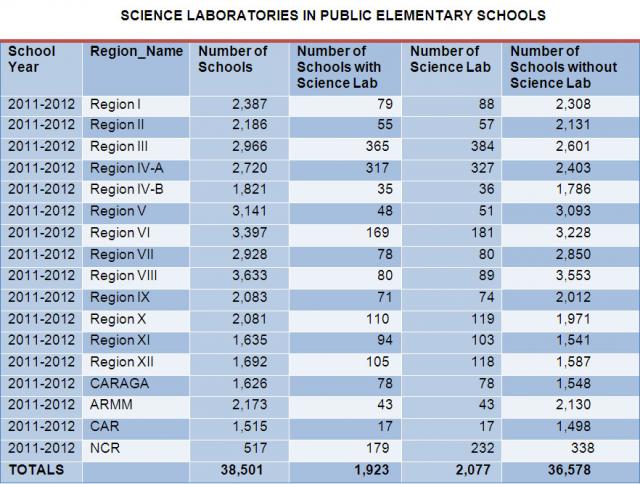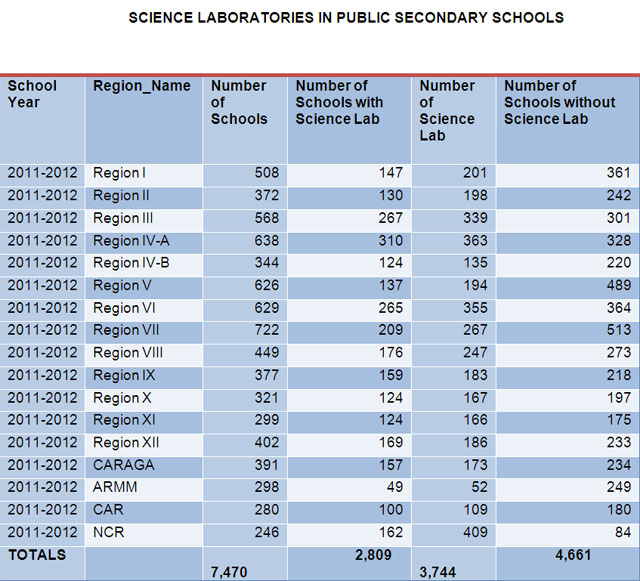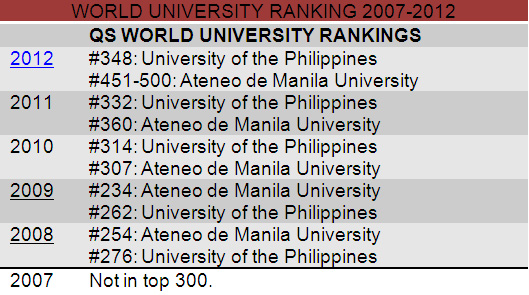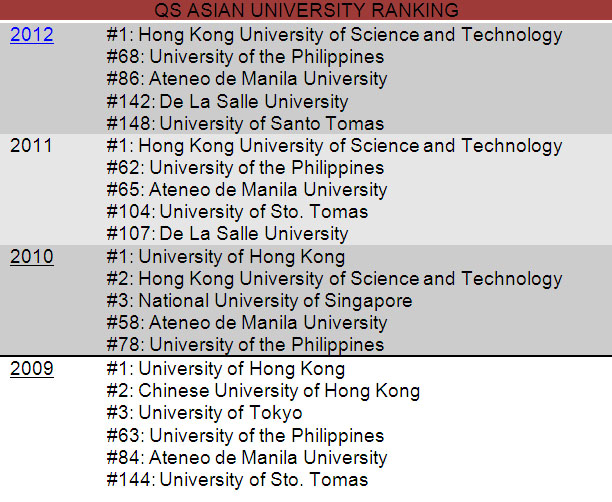The Philippines does not fare well in international university rankings. University of the Philippines, the country’s national university, dropped 16 notches in rank to number 348 in the Quacquarelli Symonds' (QS) ranking of the top 600 universities and higher education institutions in the world. The next institution from the Philippines in the top 600 is Ateneo de Manila University (ADMU), down in the 451st to 500th percentile. And but for the occasional small rise now and then, it has been a regular drop in the rankings for both schools in the last few years.
Source: QS World University Ranking by London-based Quacquarelli Symonds, 2007-2012 QS provides an annual list of world university rankings according to six measures: academic reputation; employer reputation; faculty/student ratio; citations per faculty; international faculty; and international students. The rankings have not gone unchallenged in some quarters, as critics say the criteria do not produce a truly comprehensive assessment of a school. But Philippine schools do not even rank in the top 500 of
another list, the Academic Ranking of World Universities, or in the top 200 of its lists by subject. ARWU has exacting criteria; it considers schools that have Nobel laureates, Fields Medal recipients (for mathematics), or highly cited researchers and scientific papers.
Lack of papers Part of the criteria of both lists are the quality of research papers and the amount of citations a university produces. This does not seem to be the strongest suit of the country’s higher education institutions. “[W]e are being compared in that cohort with the top universities in the world that really churn out so much research. Even the top universities here do not do even reach a fraction of what the global research universities do,” Commission on Higher Education chairperson Patricia Licuanan said in an earlier interview with GMA News.
Rankings by subject The QS rankings by subject (using the indicators of academic reputation, employer reputation and citations per paper) of the highest-ranking Philippine school, UP, reveals that it ranks 318th in Natural Sciences; 205th in Life Sciences and Medicine; and 326th in Engineering and Technology. The science and technology rankings of the second highest-ranking Philippine school, ADMU, are not listed.
Research and development handicap The low priority placed on research and development in the country has long been a matter of concern to experts in the science and engineering fields. “Obviously we are not producing enough research… There are a lot of very creative minds. There are a lot of new things that come out. But somehow maybe we do not have the organizational infrastructure for that,” Licuanan said. “May mga nakikita sila na correlated ang per capita income sa isang bansa with the quality of scientific papers produced by the scientists and researchers in that given country. Paano ba name-measure yung kahalagahan? Sa citation ng ibang scientists sa mga publications,” University of the Philippines Chancellor Caesar Saloma said in an earlier interview with GMA News. After conferring with the two others, engineer and pharmaceutical plant manager J.P. Porte said, “Hindi maliwanag kung ilang percent ng ating budget sa gobyerno ang napupunta sa research and development. Hindi katulad sa ibang bansang malalaki, mga first world countries, mga five percent ng kanilang budget ay nakatuon sa research and development kasi 'yun 'yung magpapalaki ng kanilang ekonomiya."
Are we losing our scientists? A Filipino agricultural scientist was
recently awarded the Ramon Magsaysay Award. Dr. Romulo Davide, 78, an emeritus professor at the University of the Philippines Los Baños, not only came out with an environment-friendly and chemical-free pest control, but mentored—and is still mentoring—upland farmers all over the country in the firm belief that they can become
scientists in their own way too. Davide is
not your ordinary lab scientist. However,
based on statistics, we might be losing experts like him in the country. According to CHED data from 1994 to 2011, only one-fourth of the average number of university enrollees choose engineering, information technology, and natural sciences programs. The number of graduates does not even carry that same ratio; in fact, only about 14 percent of graduates on average come from these courses. The subjects that are assumed to promise higher employment opportunities abroad get the highest number of enrollees as well as graduates—business-related courses as well as medical courses such as nursing and physical therapy. “Kung titingnan natin sa mga quality of graduates that we have, though registered na sila, pagdating sa actual work, kailangan pa rin nilang matuto ng practical application dahil siguro hindi tugma yung theory sa realidad sa industriya ‘pag nagtatrabaho na sila,” said Porte in an earlier interview with GMA News. And the neglect of the field starts even earlier, with the Department of Education reporting a serious lack of science laboratories in both elementary and high schools all over the country:

 College degree ≠ employment
College degree ≠ employment According to the UNESCO standards, the country needs to have at least 386 science and technology workers per one million of the population. Currently, the Philippines does not even have half of the required number,
with only 165 science and technology professionals for every one million Filipinos. “We are only as good as the quality of graduates that we have in the universities. If we want to pursue research and development... kailangan natin ng magagaling na graduates,” said Porte. However, deteriorating quality is just among the concerns of the tertiary education sector in the country. A college degree does not necessarily guarantee employment. For the year 2010, for example, CHED records show that more than 481,000 graduated from college. For the same year, the Department of Labor and Employment's (DOLE) records show that 621,000 college graduates were unemployed. Assuming that all of the 481,000 who graduated that year were unemployed at that time, this means at least 140,000 college graduates without suitable jobs. The labor sector of the Philippines seems to be more reactive to current market demands instead of being responsive to what our economy needs to uplift its condition. According to the National Statistics Coordination Board (NSCB) Labor Force Survey in 2010, more than half of our local employment (51.8 percent) involves services, one-third is (33 percent) in agriculture and 15.2 percent are in industries. DOLE also emphasizes the need to fill job orders abroad which mainly focus on services and production-related positions. Licuanan also said, “It needs to be communicated to students and their parents that there is a future in science and technology.” “The State needs to intervene,” said Senator Edgardo Angara, chairperson of the Senate committee on education, science and technology.
No scientific cultural heritage Another problem, says an academic, is that the history of science in the Philippines has never been particularly notable, leaving young people with no Einstein or Newton to look up to as compatriots whose scientific discoveries made a great impact on the world. “[W]ala naman tayong scientific culture unlike the kids in Germany... or in Europe," said Saloma. "I suppose, the kids, when they walk from their homes to their school, baka madadaanan na nila yung bahay ni Einstein, baka madaanan nila yung bahay ng isang famous scientist. Mai-inspire sila. So may tradisyon yung komunidad. Sa Pilipinas po during my time, wala namang tradition, no. So I really don't know how did I become a scientist, how to become a scientist.”
— BM, GMA News 


 College degree ≠ employment According to the UNESCO standards, the country needs to have at least 386 science and technology workers per one million of the population. Currently, the Philippines does not even have half of the required number, with only 165 science and technology professionals for every one million Filipinos. “We are only as good as the quality of graduates that we have in the universities. If we want to pursue research and development... kailangan natin ng magagaling na graduates,” said Porte. However, deteriorating quality is just among the concerns of the tertiary education sector in the country. A college degree does not necessarily guarantee employment. For the year 2010, for example, CHED records show that more than 481,000 graduated from college. For the same year, the Department of Labor and Employment's (DOLE) records show that 621,000 college graduates were unemployed. Assuming that all of the 481,000 who graduated that year were unemployed at that time, this means at least 140,000 college graduates without suitable jobs. The labor sector of the Philippines seems to be more reactive to current market demands instead of being responsive to what our economy needs to uplift its condition. According to the National Statistics Coordination Board (NSCB) Labor Force Survey in 2010, more than half of our local employment (51.8 percent) involves services, one-third is (33 percent) in agriculture and 15.2 percent are in industries. DOLE also emphasizes the need to fill job orders abroad which mainly focus on services and production-related positions. Licuanan also said, “It needs to be communicated to students and their parents that there is a future in science and technology.” “The State needs to intervene,” said Senator Edgardo Angara, chairperson of the Senate committee on education, science and technology. No scientific cultural heritage Another problem, says an academic, is that the history of science in the Philippines has never been particularly notable, leaving young people with no Einstein or Newton to look up to as compatriots whose scientific discoveries made a great impact on the world. “[W]ala naman tayong scientific culture unlike the kids in Germany... or in Europe," said Saloma. "I suppose, the kids, when they walk from their homes to their school, baka madadaanan na nila yung bahay ni Einstein, baka madaanan nila yung bahay ng isang famous scientist. Mai-inspire sila. So may tradisyon yung komunidad. Sa Pilipinas po during my time, wala namang tradition, no. So I really don't know how did I become a scientist, how to become a scientist.” — BM, GMA News
College degree ≠ employment According to the UNESCO standards, the country needs to have at least 386 science and technology workers per one million of the population. Currently, the Philippines does not even have half of the required number, with only 165 science and technology professionals for every one million Filipinos. “We are only as good as the quality of graduates that we have in the universities. If we want to pursue research and development... kailangan natin ng magagaling na graduates,” said Porte. However, deteriorating quality is just among the concerns of the tertiary education sector in the country. A college degree does not necessarily guarantee employment. For the year 2010, for example, CHED records show that more than 481,000 graduated from college. For the same year, the Department of Labor and Employment's (DOLE) records show that 621,000 college graduates were unemployed. Assuming that all of the 481,000 who graduated that year were unemployed at that time, this means at least 140,000 college graduates without suitable jobs. The labor sector of the Philippines seems to be more reactive to current market demands instead of being responsive to what our economy needs to uplift its condition. According to the National Statistics Coordination Board (NSCB) Labor Force Survey in 2010, more than half of our local employment (51.8 percent) involves services, one-third is (33 percent) in agriculture and 15.2 percent are in industries. DOLE also emphasizes the need to fill job orders abroad which mainly focus on services and production-related positions. Licuanan also said, “It needs to be communicated to students and their parents that there is a future in science and technology.” “The State needs to intervene,” said Senator Edgardo Angara, chairperson of the Senate committee on education, science and technology. No scientific cultural heritage Another problem, says an academic, is that the history of science in the Philippines has never been particularly notable, leaving young people with no Einstein or Newton to look up to as compatriots whose scientific discoveries made a great impact on the world. “[W]ala naman tayong scientific culture unlike the kids in Germany... or in Europe," said Saloma. "I suppose, the kids, when they walk from their homes to their school, baka madadaanan na nila yung bahay ni Einstein, baka madaanan nila yung bahay ng isang famous scientist. Mai-inspire sila. So may tradisyon yung komunidad. Sa Pilipinas po during my time, wala namang tradition, no. So I really don't know how did I become a scientist, how to become a scientist.” — BM, GMA News 



